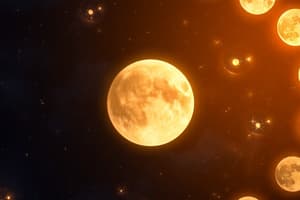Podcast
Questions and Answers
Why can't we see the moon and bright objects during the day time?
Why can't we see the moon and bright objects during the day time?
- Because the sun's bright light makes the other objects invisible during the day. (correct)
- Because the atmosphere blocks our view of the moon and bright objects during the day.
- Because the moon and stars are too far away during the day.
- Because the moon and stars disappear during the day and reappear at night.
How often can you see the full moon?
How often can you see the full moon?
- Twice a month
- Once in about a month's time (correct)
- Once a year
- Every night
What are celestial bodies?
What are celestial bodies?
- Objects that emit heat and light
- Objects made up of gases
- Objects that are very big and hot
- The sun, moon, and objects shining in the night sky (correct)
Why do stars look tiny in the night sky compared to the sun?
Why do stars look tiny in the night sky compared to the sun?
What is the Saptarishi constellation also known as?
What is the Saptarishi constellation also known as?
How is the North star also known?
How is the North star also known?
What do we call celestial bodies that are lit by the light of the stars?
What do we call celestial bodies that are lit by the light of the stars?
What is the word 'planet' derived from?
What is the word 'planet' derived from?
Which celestial body is described as a companion of Earth and moves round it?
Which celestial body is described as a companion of Earth and moves round it?
What provides the pulling force that binds the solar system?
What provides the pulling force that binds the solar system?
Flashcards are hidden until you start studying
Study Notes
Celestial Bodies and Visibility
- During the day, the moon and bright objects can't be seen because the sun's intense light overpowers their reflected light.
- The full moon is visible once a month, approximately every 29.5 days.
Characteristics of Celestial Bodies
- Celestial bodies are objects in the universe, including planets, stars, and moons.
- Stars appear tiny in the night sky compared to the sun because of their immense distance from Earth.
Constellations and Star Names
- The Saptarishi constellation is also known as the Ursa Major.
- The North Star is also known as Polaris.
Reflection and Illumination
- Celestial bodies that are lit by the light of the stars are called planets.
Origins of Celestial Body Names
- The word "planet" is derived from the Greek word "planetes", meaning "wanderer".
Earth's Companion
- The moon is a companion of Earth and moves around it in its orbit.
Gravity in the Solar System
- Gravity provides the pulling force that binds the solar system together.
Studying That Suits You
Use AI to generate personalized quizzes and flashcards to suit your learning preferences.



